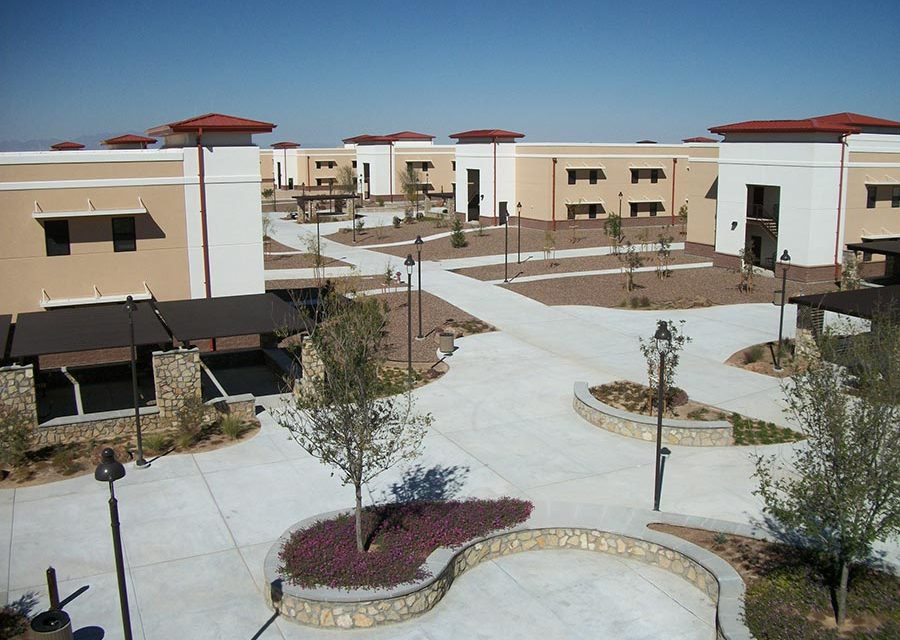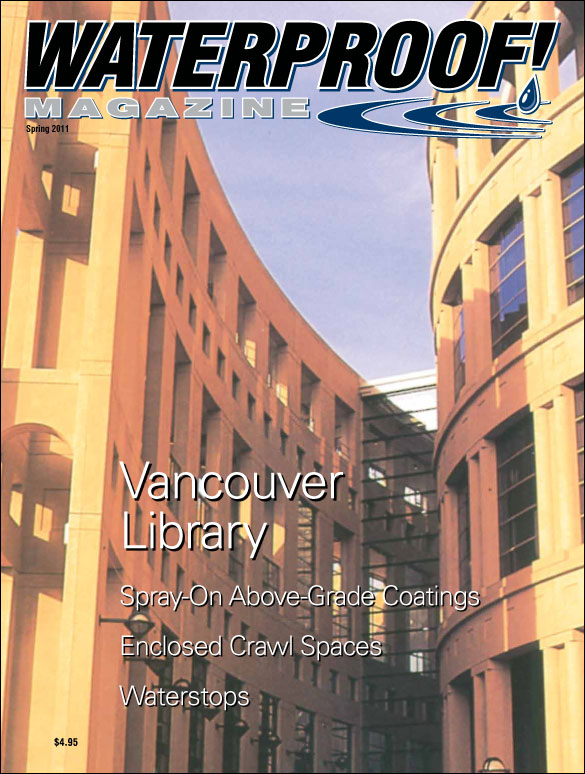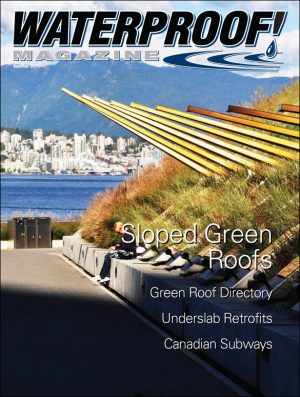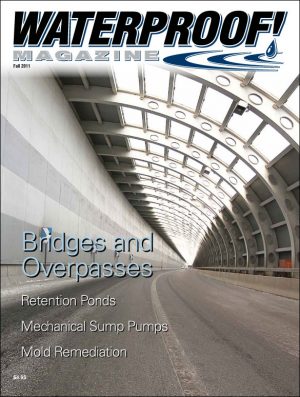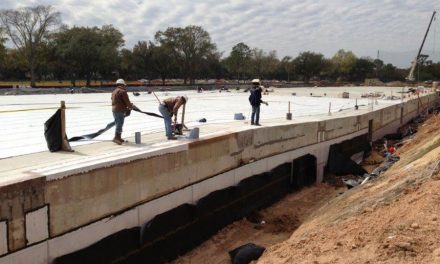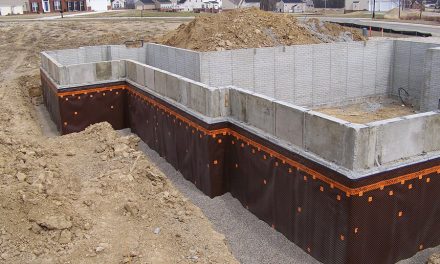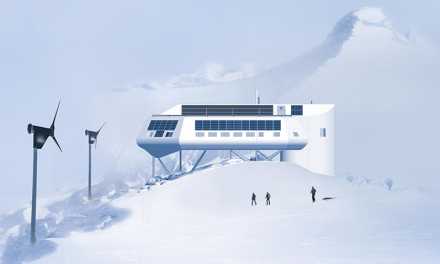With increasingly stringent energy codes and concerns about indoor air quality, both residential and commercial building envelopes are becoming tighter.
And with construction costs on the rise, manufacturers and installers are looking for ways to provide quality barriers at lower installed prices. Recent developments in spray-applied coatings make them a top choice. In fact, their performance is so outstanding that some are referring to fluid-applied air barriers as “spray-on energy efficiency.”
Specifiers are careful to point out that there are three distinct types of barriers: air, vapor, and water-resistive.
Water-resistive barriers are the most permeable, repelling liquid water while allowing vapor and air to pass through. Installed behind siding and other permeable finishes, typical water-resistive barriers include housewraps, felt paper, and rigid foam board.
Vapor barriers or vapor retarders are intended to control—not eliminate—the rate of moisture flowing through the wall assembly. The degree of permeability is typically measured in nanograms per second per cubic meter(ng/s/m2). While a water-resistive barrier must allow 300 ng/s/m2 of vapor through a wall, vapor barriers have a maximum water transmission rate of 60 ng/s/m2.
Air barriers, on the other hand, seek to eliminate all unintended movement of air into and out of a building enclosure. According to the Air Barrier Association of America (ABAA), “a properly functioning air barrier system provides a barrier against both the air leakage and the diffusion of air caused by wind, stack and mechanical equipment pressures.”
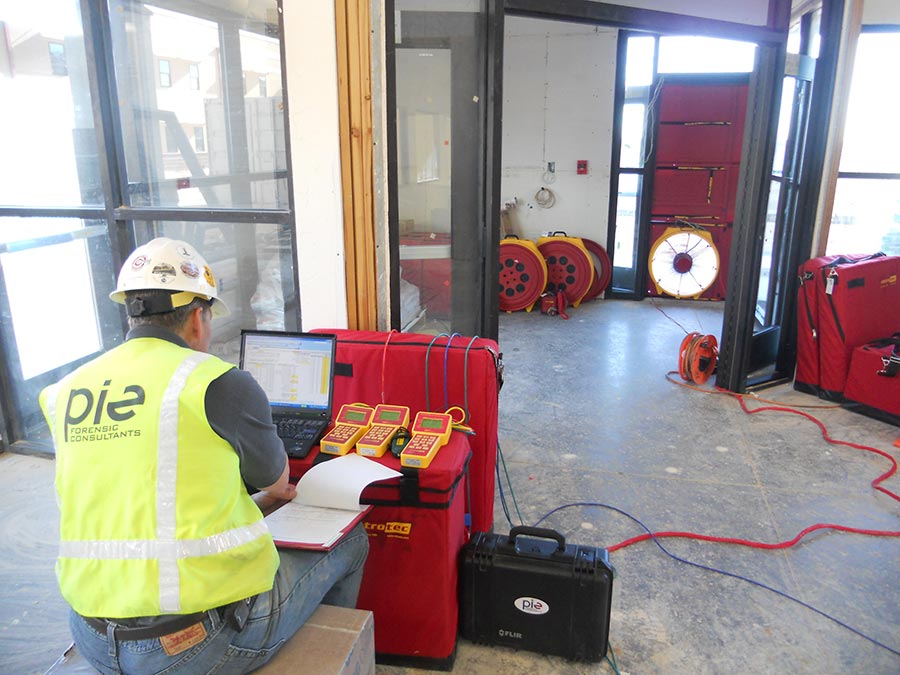
Air barriers are tested by using blower door fans to pressurize the building envelope. Results are measured by a sophisticated computer system.
The ABAA explains, “When conditioned air leaks out of a building and unconditioned air leaks in, it requires additional energy to condition the new air. Air leakage can result in increased energy costs of up to 30-40% in heating climates and 10-15% in cooling costs… Air barriers also provide a barrier to pollutants entering either the building or the building enclosure [such as] suspended particulates, dust, insects, smells, etc.”
David Cook, writing for Structural Engineering and Design magazine, notes, “Air barriers are a relatively new building component, and the majority of installers and contractors lack the training needed to perform a quality installation.”
Because air barriers often double as a vapor barrier, making sure the job is done right frequently falls to the waterproofing contractor.
A Growing Trend
Air barriers are becoming more common because codes now require them. The International Energy Conservation Code (IECC) is one major driver. Several state energy codes—Massachusetts, Wisconsin, Michigan, Louisiana, New Jersey, Ohio and Vermont—now require the use of air barriers. In Canada, air barriers have been required by code since 1990. Some federal agencies and major developer groups also require them. And because air barriers reduce energy consumption, green building trade groups are also pushing to make them mandatory.
“The codes and standards play a huge role in the use of air barriers,” says Tim Duggan, senior project director at Honeywell. “It helps buildings operate more efficiently and with greater respect for our health and environment. We’re now starting to have nationwide acceptance of the practices and are well on the way to acceptance of the air-barrier systems as being the norm with all construction of commercial buildings.”
Alec Minné, director of marketing and planning at Sto Corp. adds, “A new day is dawning for fluid-applied, vapor-permeable air barrier membranes. Recent news, from a widely publicized air barrier competition in Massachusetts and from a rigorously tested application on a military structure in Washington state, has inspired a new generation of true believers in fluid-applied membranes.”
Characteristics
The three major qualities of an air barrier are continuity, strength, and airtightness.
Continuity: The air barrier must be continuous and uninterrupted throughout the building envelope and at all penetrations, including at doors, windows and wall joints. Spray applied barriers are better than any other type at achieving this because they minimize seams. “In practice,” says Duggan, “the ability to achieve continuity at joints, cracks and penetrations outweighs the air permeance of the solid materials that make up most of the area of the air-barrier system.”
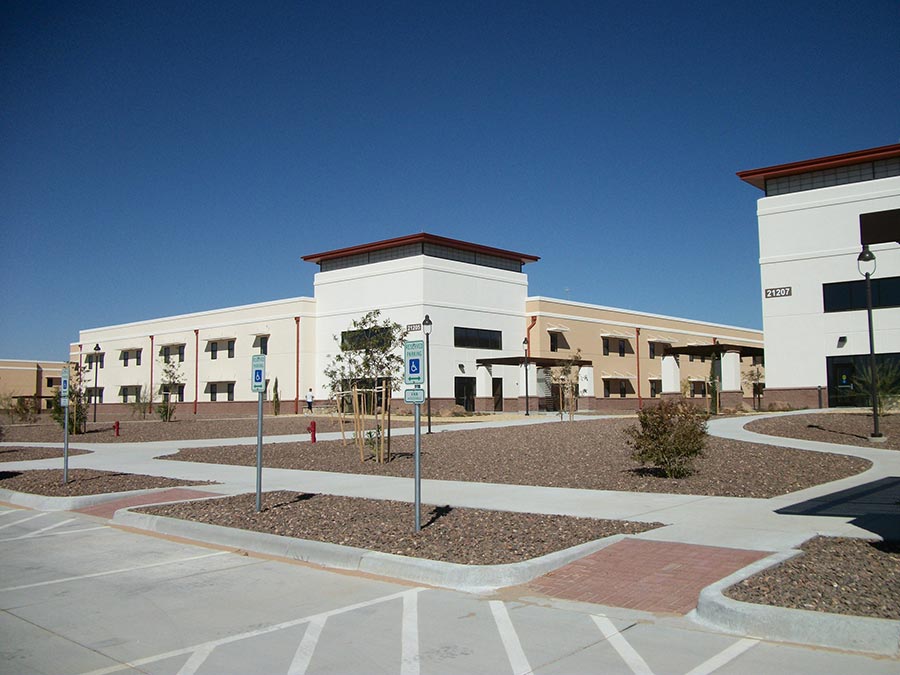
Strength. Air-barriers must be designed to transfer the wind load to the structural system. Membranes that are spray-applied over the structural sheathing meet this requirement more easily than flexible, non-adhered membrane systems.
Impermeability. Naturally, air barriers must be impermeable to air. As noted above, seams and penetrations are major weak areas, so IECC and AHRAE codes have a much looser standard for whole-building tests than for individual materials.
The maximum allowable permeability for an air barrier material is 0.004 cubic feet per minute per square foot (cfm/ft2). Air barrier assemblies can be 10 times more permeable (0.04 cfm/ft2), and whole building performance can be 100 times more permeable than the original material (0.4 cfm/ft2).
In theory, nearly any wall component—plywood, drywall, exterior sheathing, etc.—could be used as an air barrier if it were detailed correctly. But spray-applied barriers have numerous advantages.
Ted DeZurik, technical director of air barrier systems at Polyguard, explains, “Most PolyWall products are single component systems, which eliminates mixing and inconsistent performance. The product chemistry allows it to melt back together, so there’s no problem with stopping and starting, or doing touchups. Transitional membranes can adhere to it, which eliminates touchup and overspray steps. Skilled applicators can apply up to 10,000 sq. ft. daily.”
DeZurik notes that PolyWall can be applied in temperatures from -20ºF to 110ºF, reduces scheduling delays and weather-related installation problems.
Effectiveness
Minné, at Sto, says, “It might be a simple lack of familiarity, or it might be the apparent thinness of fluid-applied air barriers that gives architects and contractors pause. But air barriers, even very thin ones, have shown they can yield exceptional results.”
Polyguard’s PolyWall AirLok Flex, for instance can pass the same ASTM air barrier tests as an asphalt-based coating while being five times thinner. “Why pay for extra product you don’t need?” asks Minné.
Even super-thin air barriers—about 6 mils thick—have yielded impressive energy savings. According to lab tests carried out by the National Institute of Standards and Technology (NIST) air-barrier systems in nonresidential buildings are estimated to reduce air leakage by up to 83%, cutting gas bills by more than 40% and reducing electrical consumption by more than 25%.
While the results of this particular NIST study have not duplicated outside the lab, other field tests are compelling.
Senershield-R, a fluid-applied air barrier from BASF, was recently used on 24 buildings at Fort Bliss, Texas, which were then tested extensively for air leakage.
The project, which began in August 2009, consists of constructing 24 soldier barracks to meet the new U.S. Army Corps of Engineer air barrier requirements. The total size of each building envelope is 71,312 sq. ft. Each of the barracks is a two-story building with exterior envelope walls consisting of plywood sheathing over wood framing. Senershield-R fluid air/water-resistive barrier was applied over the sheathed walls, and all joints and openings were carefully flashed.
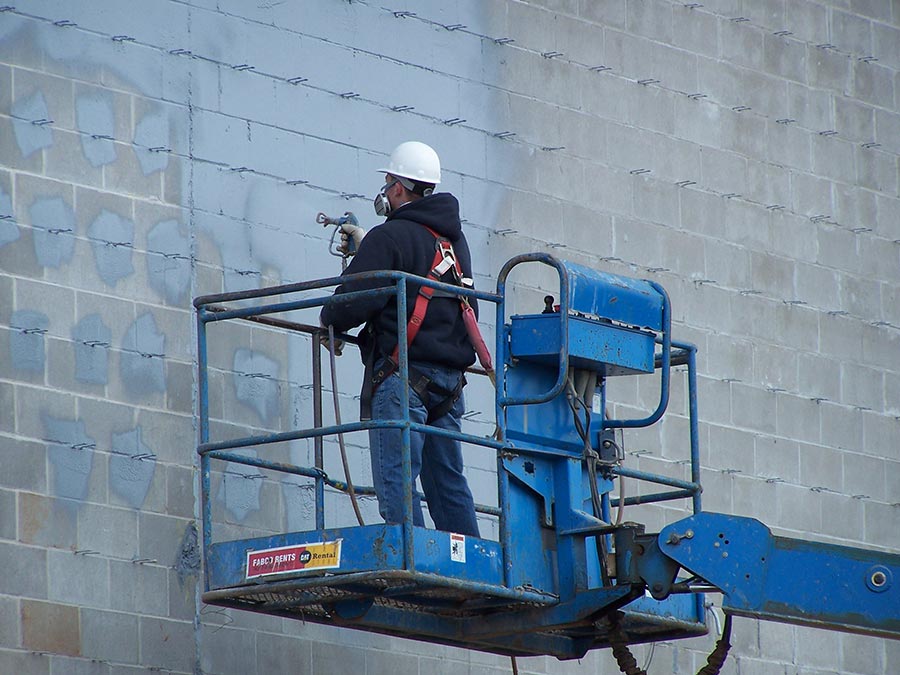
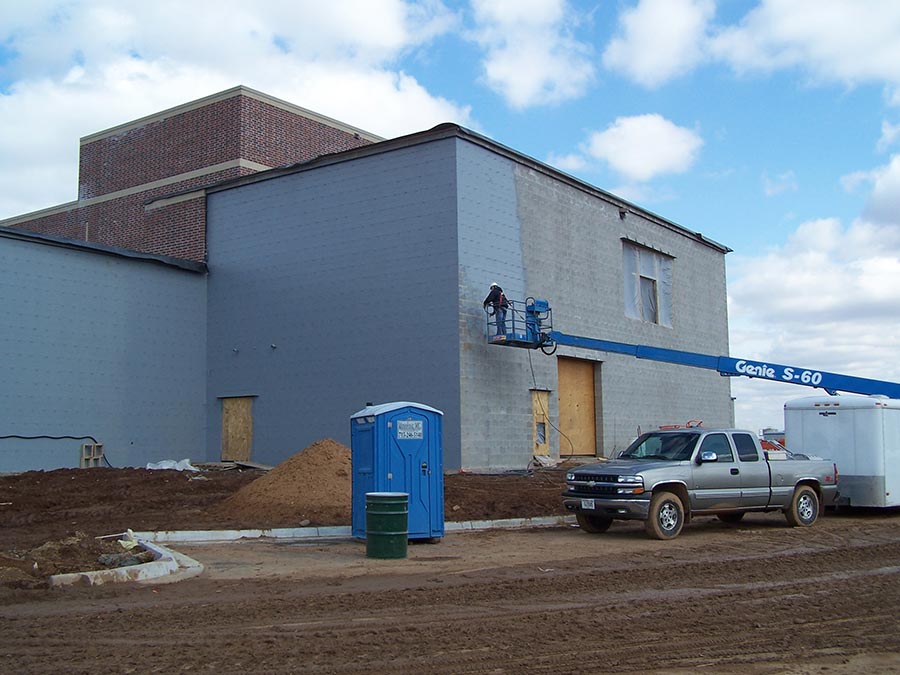
Spray-applied air barriers, such as Polywall’s AirLok being applied above, are especially effective because they minimize seams and detailing, and effortlessly conform to unusual shapes. Skilled applicators can install 10,000 sq. ft. or more per day.
The installation subcontractor was familiar with the product, but the job was unusually large and complex. According to project manager Blake Anderson, “The production schedule was tight and required us to complete more than two buildings every month. Completion of the Senershield-R air barriers was on the critical path. With the requirement for fan pressurization testing on each building, we could not afford any surprises, mistakes or delays.”
Although the company had spray-applied Senershield-R on other projects, they chose roller application based upon project layout and site conditions. Mock-ups showing all critical details were prepared on site, and reviewed by the product manufacturer, building owner, general contractor, and the installation crew.
By April 2010, the first building was ready for blower-door tests. Over the next six months, all 24 buildings were tested. All of them passed during the first round of testing, and far exceeded the standards.
According to ASHRAE 189.1, set to be adopted in the 2012 International Energy Conservation Code, the maximum allowable whole building leakage for commercial buildings is 0.40 cubic feet per minute per square foot (cfm/ft²). Army Corps of Engineer minimum standards are more stringent at 0.25 cfm/ft². The 24 barracks at Fort Bliss averaged 0.07 cfm/ft².
Eric Amhaus, a principal with Pie Forensic Consultants which conducted the testing, stated; “The fact that the test results for all 24 buildings were so exceptional supports that similar results can be achieved on other buildings with like construction, materials and attention to detail in both the design and construction phases.”
StoGuard, a fluid-applied air membrane from Sto Corp, was used on a similar, concurrent project at Fort Lewis, Washington. Field-testing in June 2010 used whole building pressurization and thermal imaging to pinpoint energy leakage.
The minimum USACE standard was 0.25 cfm/ft², and the StoGuard wall assembly scored 0.18 cfm/ft² in initial testing, and 0.11 cfm/ft² in final testing.
Options
Of course, the products mentioned in this story are not the only fluid-applied air barrier on the market. According to Duggan at Honeywell, at least 45 different products meet the minimal properties of a high-performance air barrier.
Henry Company, for instance, has a line of mold resistant spray-applied air barriers. The Air-Bloc 30-MR series incorporate a biocidal agent throughout the cured membrane to resist mold, mildew and fungus growth.
“Controlling moisture is key in controlling mold,” says Marc Tropper, director of product management for Henry Company. “The right choice of air barrier can help control moisture within the building envelope by reducing air leakage and rain penetration. The addition of antimicrobial agents to Air-Bloc MR air barriers is an added feature to help reduce the risk of exponential mold proliferation on the surface of our products.”
Polyguard also offers a mold inhibitor called ProBan that can be added to any of its air barrier products.
- In choosing an air barrier, the National Institute of Building Sciences (NIBS) recommends that it should meet the following requirements:
- The product must have a relatively short cure time—less than 24 hours, if possible—to establish membrane integrity and bonding.
- If water-based, the product should not freeze if applied during winter weather conditions.
- The product should not be a water-soluble material after curing.
- If the project is being completed in an urban setting or near another occupied building, exterior spray-applied products should be avoided or used with caution.
- Any product must be relatively easy to inspect after application.
- The product must be able to bridge at least a ¼-inch gap. Not all liquid-applied air-barrier materials meet this requirement.
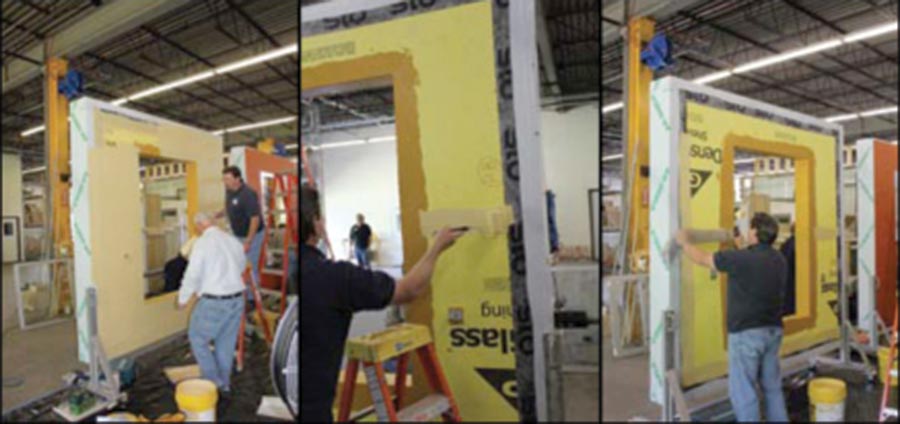
The Boston chapter of the Building Enclosure Council (BEC) sponsored the 2010 Air Barrier Challenge. Nine participating teams assembled an 8-foot by 8-foot mockup of a building envelope, which was tested for air infiltration (according to ASTM E 783) and water penetration (according to ASTM E 1105). Surprisingly, thicker membranes- sometimes up to 45 dry mils – did not perform as well as a fluid-applied system of only about 6 dry mils thick on the wall.
Installation is Key
Richard Keleher is senior architect with the Thompson & Lichtner Company and member of the Building Enclosure Council. He organized an “Air Barrier Challenge” in May 2010 between nine different teams. Each group would build a 8-foot by 8-foot mockup of a building envelope, which would undergo testing for air infiltration and water penetration. The results were somewhat surprising. Membrane thickness had little to do with the final performance of the assembly.
“Application is the key,” says Keleher.“ [The Challenge] showed that a lot of people who thought they knew how to put together a membrane couldn’t,” Keleher remarks. “Several consultant teams had trouble, which had to do with
‘fish mouths’ and small gaps where membranes crossed. Workmanship is critical.”
Wei Lam, an active BEC-Boston member and senior associate with Wiss, Janney, Elstner Associates, Inc. who participated in the challenge, concurs. “One of the best lessons learned from this exercise is that what you can draw on paper will be far more challenging in the field.”
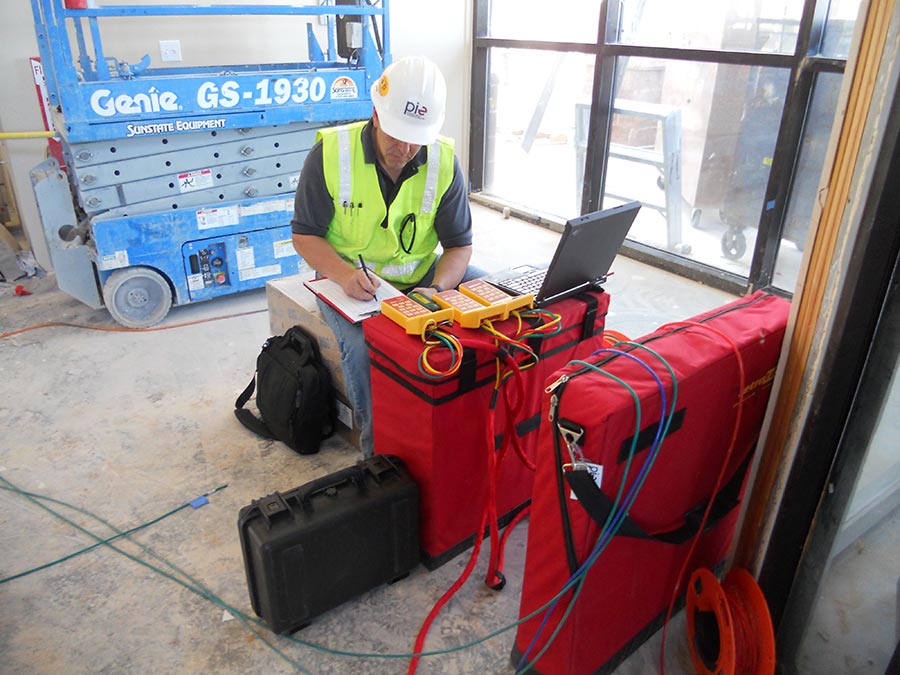
Taken together, the field and lab results make the prospects for fluid-applied membranes look very promising. Still, the caveats offered by enclosure specialists Keleher and Lam are important ones, especially with respect to ensuring that contractors are sufficiently well versed in fluid-applied products.
“In assembly, you have to start right and avoid mistakes early, because they compound,” Keleher reminds us. “Trying later in the process to make up for a wrinkle or other error can in itself become another problem.”
Spring 2011 Back Issue
$4.95
Waterstops, How and Why
Project Profile: Vancouver Library
New Data on Enclosed Crawlspaces
Spray-on Coatings for Above-Grade Work
AVAILABLE AS DIGITAL DOWNLOAD ONLY
Description
Description
Waterstops, How and Why:
Long used for heavy commercial work—especially in tunnels and retention ponds—waterstops are becoming more common for waterproofing light commercial jobs as well.
Project Profile: Vancouver Library
As innovative as it is green, this project showcases a wide array of new waterproofing technologies, from the integral waterproofing in the foundation to the green roof fifty feet above grade.
New Data on Enclosed Crawlspaces
As energy efficiency has become a top priority for homebuilders, enclosed crawlspaces are becoming more common. But the contractor must be careful to avoid the condensation and mold issues that can become problematic in poor quality installations.
Spray-on Coatings for Above-Grade Work
Recent developments in spray-applied coatings make them a top choice for above grade work. Compare the advantages, and find the product that’s best for your next job.
Additional Info
Additional information
| Magazine Format | Digital Download Magazine, Print Mailed Magazine |
|---|

